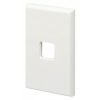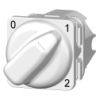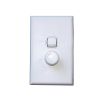Speed Controllers
Using a Speed Controller with a Ventilation Fan.
Fans all perform the basic function of moving air from one space to another. When a fan is selected for an application, it is often designed for worst-case conditions. This means selecting a fan that can move enough air against the pressure of duct, grilles etc, to meet the building code requirements. Worst-case scenarios could include; ambient temperatures, power dissipation, fan production tolerances, and fan aging, duct lengths, bends, grilles and filter pressure drops.
The reality of the situation is the system will spend most of its time well under worst-case conditions. At this point, the fan speed can be reduced without adverse effects on the system and increased when conditions demand.
With speed control, the fan can moderate its performance as required by the conditions making it more efficient and reducing the strain on the equipment.
Energy saving
Operating a fan further down the curve can have significant effects on its power consumption. This is clearly illustrated with the use of the fan laws.
Reduced Audible Noise.
One of the most immediately noticeable advantages of fan speed control comes in the form of relief for your ears. Fans running at full speed can be a significant source of annoyance, especially for equipment used in quiet office environments.
Fan speed control is useful for increasing the reliability, reducing the power consumption, and decreasing the noise of systems.
The range of speed controllers is broken into three main types. Each type has a range of products with different rated load or user controls.
The controllers should be sized by the motor FLA (Full Load Amps) rating.
Speed Limiters
These units are designed as "set and forget". primarily for air balancing and set at commissioning.
Speed Controllers
These units are designed to let the user adjust the speed of the fan. They are commonly used where the fan speed needs to vary according to how much airflow is required.
Variable Speed Drives
These units take a signal as an input to control the motor speed. They are typically interfaced with a BMS (Building Management System) or PLC (Programmable Logic Controller) so that the motor speed is adjusted as required.
| Code | Product | Price | Min. Quantity |
Status | Quantity | |
|---|---|---|---|---|---|---|

|
PDL681VH | PDL681VH Face Plate Single Switch |
RRP
$14.50
$12.60
|
0 | Available from Stock | |

|
ME1.12 | ME1.12 ME1.12 Speed Controller Max Load 12 Amp |
RRP
$975.00
$1,132.17
|
1 | Available from Stock | |

|
ME1.3 | ME1.3 ME1.3 Speed Controller Max Load 3 Amp |
RRP
$520.00
$452.17
|
1 | Available from Stock | |

|
ME1.6 | ME1.6 ME1.6 Speed Controller Max Load 6 Amp |
RRP
$535.00
$465.22
|
1 | Available from Stock | |

|
MSC1200 | MSC1200 MSC1200 Speed Controller Max Load 5 Amp |
RRP
$425.00
$369.57
|
0 | Available from Stock | |

|
PDL687M3 | PDL687M3 Switch 3 Position Rotary |
RRP
$28.00
$24.35
|
0 | Available from Stock | |

|
PDL687M4 | PDL687M4 Switch 4 Position Rotary |
RRP
$28.00
$24.35
|
1 | Available from Stock | |

|
VA2.0 | VA2.0 VA2.0 Speed Controller Variable Fan Max Load 2 Amp |
RRP
$132.50
$115.22
|
0 | Available from Stock | |

|
E510-403-H3F | E510-403-H3F VSD TECO E510-403-H3F 2.2kW (5.2A) |
RRP
$3,187.50
$2,771.74
|
1 | Indent 10 days + |
